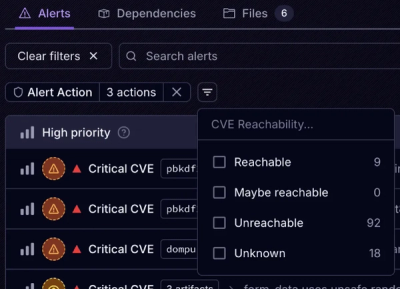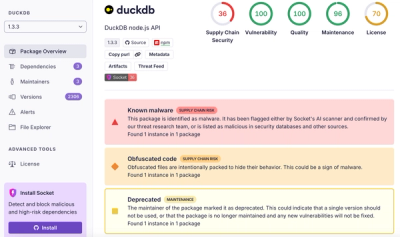
Product
Introducing Tier 1 Reachability: Precision CVE Triage for Enterprise Teams
Socket’s new Tier 1 Reachability filters out up to 80% of irrelevant CVEs, so security teams can focus on the vulnerabilities that matter.
A simple async python wrapper for the Firebase API.
pip install git+https://github.com/09ghostrider/firebase-aio
Firebase-aio was written for python 3 and will not work correctly with python 2.
For use with only user based authentication we can create the following configuration:
import firebaseaio
config = {
"apiKey": "apiKey",
"authDomain": "projectId.firebaseapp.com",
"databaseURL": "https://databaseName.firebaseio.com",
"storageBucket": "projectId.appspot.com"
}
firebase = firebaseaio.initialize_app(config)
We can optionally add a service account credential to our configuration that will allow our server to authenticate with Firebase as an admin and disregard any security rules.
import firebaseaio
config = {
"apiKey": "apiKey",
"authDomain": "projectId.firebaseapp.com",
"databaseURL": "https://databaseName.firebaseio.com",
"storageBucket": "projectId.appspot.com",
"serviceAccount": "path/to/serviceAccountCredentials.json"
}
firebase = firebaseaio.initialize_app(config)
Adding a service account will authenticate as an admin by default for all database queries, check out the Authentication documentation for how to authenticate users.
A firebase-aio app can only use Firebase database services.
firebase.database() -
Check out the Database documentation for further details.
You can build paths to your data by using the child() method.
db = firebase.database()
db.child("users").child("Morty")
To save data with a unique, auto-generated, timestamp-based key, use the push() method.
data = {"name": "Mortimer 'Morty' Smith"}
await db.child("users").push(data)
To create your own keys use the set() method. The key in the example below is "Morty".
data = {"name": "Mortimer 'Morty' Smith"}
await db.child("users").child("Morty").set(data)
To update data for an existing entry use the update() method.
await db.child("users").child("Morty").update({"name": "Mortiest Morty"})
To delete data for an existing entry use the remove() method.
await db.child("users").child("Morty").remove()
You can also perform multi-location updates with the update() method.
data = {
"users/Morty/": {
"name": "Mortimer 'Morty' Smith"
},
"users/Rick/": {
"name": "Rick Sanchez"
}
}
await db.update(data)
To perform multi-location writes to new locations we can use the generate_key() method.
data = {
"users/"+ref.generate_key(): {
"name": "Mortimer 'Morty' Smith"
},
"users/"+ref.generate_key(): {
"name": "Rick Sanchez"
}
}
await db.update(data)
Queries return a PyreResponse object. Calling val() on these objects returns the query data.
users = await db.child("users").get()
print(users.val()) # {"Morty": {"name": "Mortimer 'Morty' Smith"}, "Rick": {"name": "Rick Sanchez"}}
Calling key() returns the key for the query data.
user = await db.child("users").get()
print(user.key()) # users
Returns a list of objects on each of which you can call val() and key().
all_users = await db.child("users").get()
for user in all_users.each():
print(user.key()) # Morty
print(user.val()) # {name": "Mortimer 'Morty' Smith"}
To return data from a path simply call the get() method.
all_users = await db.child("users").get()
It's possible to do conditional sets and removes by using the conditional_set() and conitional_remove() methods respectively. You can read more about conditional requests in Firebase here.
To use these methods, you first get the ETag of a particular path by using the get_etag() method. You can then use that tag in your conditional request.
etag = await db.child("users").child("Morty").get_etag()
data = {"name": "Mortimer 'Morty' Smith"}
await db.child("users").child("Morty").conditional_set(data, etag)
If the passed ETag does not match the ETag of the path in the database, the data will not be written, and both conditional request methods will return a single key-value pair with the new ETag to use of the following form:
{ "ETag": "8KnE63B6HiKp67Wf3HQrXanujSM=" }
Here's an example of checking whether or not a conditional removal was successful:
etag = await db.child("users").child("Morty").get_etag()
response = await db.child("users").child("Morty").conditional_remove(etag)
if "ETag" in response:
etag = response["ETag"] # our ETag was out-of-date
else:
print("We removed the data successfully!")
To return just the keys at a particular path use the shallow() method.
all_user_ids = await db.child("users").shallow().get()
Note: shallow() can not be used in conjunction with any complex queries.
You can listen to live changes to your data with the stream() method.
def stream_handler(message):
print(message["event"]) # put
print(message["path"]) # /-K7yGTTEp7O549EzTYtI
print(message["data"]) # {'title': 'firebaseaio', "body": "etc..."}
my_stream = db.child("posts").stream(stream_handler)
You should at least handle put and patch events. Refer to "Streaming from the REST API" for details.
You can also add a stream_id to help you identify a stream if you have multiple running:
my_stream = db.child("posts").stream(stream_handler, stream_id="new_posts")
my_stream.close()
Queries can be built by chaining multiple query parameters together.
users_by_name = await db.child("users").order_by_child("name").limit_to_first(3).get()
This query will return the first three users ordered by name.
We begin any complex query with order_by_child().
users_by_name = await db.child("users").order_by_child("name").get()
This query will return users ordered by name.
Return data with a specific value.
users_by_score = await db.child("users").order_by_child("score").equal_to(10).get()
This query will return users with a score of 10.
Specify a range in your data.
users_by_score = await db.child("users").order_by_child("score").start_at(3).end_at(10).get()
This query returns users ordered by score and with a score between 3 and 10.
Limits data returned.
users_by_score = await db.child("users").order_by_child("score").limit_to_first(5).get()
This query returns the first five users ordered by score.
When using order_by_key() to sort your data, data is returned in ascending order by key.
users_by_key = await db.child("users").order_by_key().get()
When using order_by_value(), children are ordered by their value.
users_by_value = await db.child("users").order_by_value().get()
db.generate_key() is an implementation of Firebase's key generation algorithm.
See multi-location updates for a potential use case.
Sometimes we might want to sort our data multiple times. For example, we might want to retrieve all articles written between a
certain date then sort those articles based on the number of likes.
Currently the REST API only allows us to sort our data once, so the sort() method bridges this gap.
articles = await db.child("articles").order_by_child("date").start_at(startDate).end_at(endDate).get()
articles_by_likes = db.sort(articles, "likes")
Indexing is not enabled for the database reference.
FAQs
A simple async python wrapper for the [Firebase API](https://firebase.google.com).
We found that firebaseaio demonstrated a healthy version release cadence and project activity because the last version was released less than a year ago. It has 1 open source maintainer collaborating on the project.
Did you know?

Socket for GitHub automatically highlights issues in each pull request and monitors the health of all your open source dependencies. Discover the contents of your packages and block harmful activity before you install or update your dependencies.

Product
Socket’s new Tier 1 Reachability filters out up to 80% of irrelevant CVEs, so security teams can focus on the vulnerabilities that matter.

Research
/Security News
Ongoing npm supply chain attack spreads to DuckDB: multiple packages compromised with the same wallet-drainer malware.

Security News
The MCP Steering Committee has launched the official MCP Registry in preview, a central hub for discovering and publishing MCP servers.